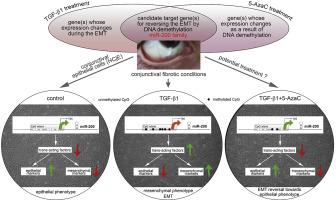Experimental Eye Research ( IF 3.0 ) Pub Date : 2020-05-05 , DOI: 10.1016/j.exer.2020.108047 Jovana Rajić 1 , Svetlana Dinić 1 , Aleksandra Uskoković 1 , Jelena Arambašić Jovanović 1 , Anja Tolić 1 , Marija Đorđević 1 , Miloš Đorđević 1 , Goran Poznanović 1 , Mirjana Mihailović 1 , Aleksandra Inic-Kanada 2 , Talin Barisani-Asenbauer 3 , Nevena Grdović 1 , Melita Vidaković 1

|
Epithelial to mesenchymal transition (EMT) contributes to fibrosis associated pathologies including scarring of different ocular tissues. Recently targeting EMT is seen as an appropriate therapeutic approach for different fibrosis related eye diseases such as macular degeneration or glaucoma surgery related fibrosis. Nevertheless, for ocular surface diseases, target genes specific for particular cell type or condition are still undefined. This study aimed to expose the complex regulatory mechanisms that trigger EMT in human conjunctival epithelial (HCjE) cells. EMT was induced by prolonged treatment with two TGF-β isoforms, TGF-β1 and TGF-β2, and their combination. TGF-β1 showed the strongest potential for initiating EMT in HCjE cells, reflected on morphological changes, cell migration and the levels of mRNA expression of different epithelial (CDH1, OCLN, DSP) and mesenchymal (CDH2, FN1, VIM, SNAI1, ZEB2, TWIST1) marker genes. Co-treatment with the DNA demethylating agent 5-Azacytidine (5-AzaC) was capable of stopping the transition of HCjE cells towards a mesenchymal phenotype, based on morphological features, reduced cell mobility and mRNA and protein expression levels of epithelial and mesenchymal marker genes. An EMT qRT-PCR-based array revealed that EMT induced considerable alterations in gene expression, with downregulation of the majority of epithelial marker genes and upregulation of genes specific for the mesenchymal state. The major effect of 5-AzaC treatment was observed as a suppression of mesenchymal marker genes, suggesting the involvement of upstream negative regulator(s) whose promoter demethylation and subsequent expression will in turn promote EMT switch off. The expression level of miRNAs potentially important for EMT induction was determined using qRT-PCR-based array which pointed at members of miR-200 family as main regulators of EMT process in HCjE cells. 5-AzaC treatment induced increased expression of miR-200a, −200b, −200c and miR-141 towards the control level, indicating important role of DNA methylation in their regulation. The DNA methylation status of both miR-200 family clusters, analyzed with high-resolution melting (HRM) and bisulfite sequencing (Bis-Seq), revealed that TGF-β1-induced EMT was accompanied by increase in promoter CpG methylation of both miR-200 loci, which was reverted after 5-AzaC treatment. In conclusion, our results indicate that DNA demethylation of promoters of miR-200 loci is critically important for stopping and reverting the EMT in human conjunctival epithelial cells, suggesting the potential for the development of novel epigenetic-based therapeutic strategies for treating conjunctival conditions associated with EMT.
中文翻译:

miR-200簇的DNA甲基化促进人结膜上皮细胞中的上皮向间质转化。
上皮到间充质转变(EMT)有助于与纤维化相关的病理,包括不同眼组织的瘢痕形成。最近,针对EMT的治疗被视为针对与各种纤维化相关的眼部疾病(如黄斑变性或青光眼手术相关的纤维化)的适当治疗方法。然而,对于眼表疾病,仍未确定特定于特定细胞类型或状况的靶基因。这项研究旨在揭示触发人类结膜上皮(HCjE)细胞EMT的复杂调控机制。通过长期用两种TGF-β同工型TGF-β1和TGF-β2及其组合诱导EMT。TGF-β1在HCjE细胞中显示出最强的EMT启动潜能,反映在形态变化,细胞迁移和不同上皮细胞的mRNA表达水平上(CDH1,OCLN,DSP)和间充质(CDH2,FN1,VIM,SNAI1,ZEB2,TWIST1)标记基因。与DNA脱甲基剂5-氮杂胞苷(5-AzaC)共同处理能够停止HCjE细胞向间充质表型的转变,这是基于形态特征,降低的细胞迁移率以及上皮和间充质标记基因的mRNA和蛋白表达水平。基于EMT qRT-PCR的阵列显示EMT诱导了基因表达的显着变化,同时大多数上皮标记物基因下调并且间充质状态特异性基因上调。观察到5-AzaC处理的主要作用是抑制间充质标记基因,表明上游负调节剂的参与,其启动子去甲基化和随后的表达反过来会促进EMT的关闭。使用基于qRT-PCR的阵列确定了可能对EMT诱导潜在重要的miRNA的表达水平,该阵列指出miR-200家族成员是HCjE细胞中EMT过程的主要调节因子。5-AzaC处理诱导miR-200a,-200b,-200c和miR-141的表达朝着对照水平增加,表明DNA甲基化在其调节中起重要作用。用高分辨率熔解(HRM)和亚硫酸氢盐测序(Bis-Seq)分析了两个miR-200家族簇的DNA甲基化状态,发现TGF-β1诱导的EMT伴随着两个miR-200启动子CpG甲基化的增加。 200个基因座,经5-AzaC处理后恢复原位。结论,











































 京公网安备 11010802027423号
京公网安备 11010802027423号